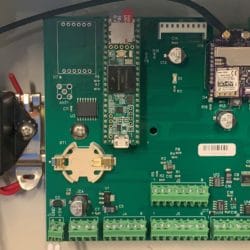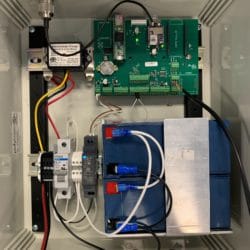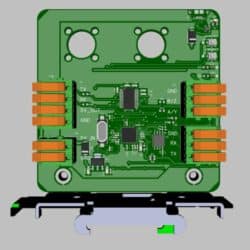Home › Forums › Other Data Loggers › Using the Teensy 3.5
- This topic has 12 replies, 2 voices, and was last updated 2023-10-27 at 3:54 PM by
Rick Vogel.
-
AuthorPosts
-
-
2021-08-03 at 1:07 PM #15779Setting up this topic at the request of @neilh to discuss advances we have made using the Teensy 3.5 board for logging data and have been able to establish remote updating, as well as, a bootloader thSetting up this topic at the request of @neilh to discuss advances we have made using the Teensy 3.5 board for logging data and have been able to establish remote updating, as well as, a bootloader that allows for boot from the loaded program, but checks for boot file on the uSD card first as a potential update to the program.
Bootloader is taken from the uTasker project: https://www.utasker.com/kinetis/TEENSY_3.5.html
Solar Charger(Dual Battery version): https://cdn.shopify.com/s/files/1/0079/6003/5417/files/ASC30W_Installation_Manual.pdf
Cellular: XBee LTE-M/NB IoT
- Used for both MQTT with TLS 1.2 and FTP-Secure for remote updating of Xbee and Teensy files
- Teensy files are pulled down by Xbee and transferred via serial to Teensy. Teensy writes to SD Card as received and reboots
- Used for both MQTT with TLS 1.2 and FTP-Secure for remote updating of Xbee and Teensy files
-
2021-08-03 at 2:57 PM #15783@vogelrnws thanks. Would you have an overall schematic of it. Sounds like Solar to +12V. Then guessing +12V battery that is the main power source. Then Teensy3.5 supply 3.5to5.5V, possibly also@vogelrnws thanks. Would you have an overall schematic of it. Sounds like Solar to +12V. Then guessing +12V battery that is the main power source. Then Teensy3.5 supply 3.5to5.5V, possibly also Xbee LTE boards
https://www.pjrc.com/store/teensy35.html
Probably a carrier board for the Teensy3.4 and LTE board?
-
2021-08-03 at 3:09 PM #15785@neilh,
Yes, we have solar to the charger and into (2)12V 9aH batteries (in parallel). The Teensy and Xbee are on a custom motherboard we designed. Has lots of the IO broken out and spots for Adafrui
@neilh,Yes, we have solar to the charger and into (2)12V 9aH batteries (in parallel). The Teensy and Xbee are on a custom motherboard we designed. Has lots of the IO broken out and spots for Adafruit GPS, RTC battery, ESP32 (older requirement) and Wiz850io Ethernet.
See pic attached
Attachments:
-
2021-08-03 at 3:16 PM #15787
12V to 5V is a DC/DC Din Rail supply P/N: MDR-20-5. The board takes in 5V and and has a 3.3V LDO onboard for those 3.3V parts that pull more than the teensy 3.3V output can provide.
-
2021-08-03 at 5:02 PM #15789Ahh very nice. I’m sure its worth it to get a standard design for all climates, and able to cope with keeping some sensors warm. Seems like the cost is going to go up dramatically though.Ahh very nice. I’m sure its worth it to get a standard design for all climates, and able to cope with keeping some sensors warm. Seems like the cost is going to go up dramatically though. Powering is a lot of cost and of course IP65 space is costly (for those batteries!!). I wonder if it is open sourced, or a private contract design. I use a 4.4AH LiIon, which is quite large for the Mayfly, and of course it can only charge at a max of 0.5A/hr – which means the solar panel is only about 3Watts (though easy to oversize to cope with shading) . Thanks for sharing and the references.
-
2021-08-03 at 6:08 PM #15790We use a polycase 12x10x6 customized enclosure for under $85 with everything predrilled https://www.polycase.com/yh-121006.
We made a custom din rail bracket to hold the two batteries. 10W panel for
We use a polycase 12x10x6 customized enclosure for under $85 with everything predrilled https://www.polycase.com/yh-121006.We made a custom din rail bracket to hold the two batteries. 10W panel for solar but charger will accommodate up to 30W
-
2021-08-03 at 7:03 PM #15791Thanks, good for reference – the critical aspect of any plastic outdoor box is I understand polycarbonate and those IP65 seals 🙂 Keep out the falling rain. Those ants like to get in if they canThanks, good for reference – the critical aspect of any plastic outdoor box is I understand polycarbonate and those IP65 seals 🙂 Keep out the falling rain. Those ants like to get in if they can, so it is a challenge. I really appreciate the detailed guide of what to think about with https://www.envirodiy.org/mayfly-sensor-station-manual/ though I choose my polycarbonate box based on the project.
When building a system, I do try and document it for myself so that I can easily repeat it, and also share it. The Mayfly can fit in a small space ~ NBB-15240 with the uSD facing outwards for easy offloading.
Sometimes though its the instrument wires and dessicant that need routing space, so I’ve also been using the Bud PTQ-11050 and for testing PTQ-11050-C.Still it would be soo nice to have a processor with at least 4 UARTs, an embedded USB host, and a 1M flash, enough ram and timers for totalizing/counting … with a little screen for site provisioning. I’m playing around with the Wio Terminal – https://wiki.seeedstudio.com/Wio-Terminal-Getting-Started/ but how to get the sleep power usage down, and have it take an Xbee format socket with Digi LTE powering, with all the software open source license…. as ever a variety of engineering challenges. 🙂
-
2021-08-04 at 1:15 PM #15794
I misspoke on the DC/DC supply. It is a Meanwell DDR-15G-5. Pic of the guts on that polycase is attached.
Attachments:
-
2021-08-05 at 10:07 PM #15813@vogelrnws nice to se the layout. That battery holder looks pretty solid and as you said 2 *12V * 9Ah gives 216WHr of capacity. a LiIon at 4.4AH @ 4V is 16Ah.
Its great to have a discussion about the@vogelrnws nice to se the layout. That battery holder looks pretty solid and as you said 2 *12V * 9Ah gives 216WHr of capacity. a LiIon at 4.4AH @ 4V is 16Ah.
Its great to have a discussion about the mechanical side, what works, what doesn’t work so well.
Seems like on of the challenges is that uSD is right up against the side of the cabinet – doesn’t appear like it can be easily removed. Would require the Teensy 3.5 to be pulled first.
I wonder also if there is any protection for static/lightening on the instrument leads. That’s a problem in certain parts of the country.The DIN rails take some thinking about. The issue as I see it is how to do assembly simple and reliably. If the screws are inserted from the front, and require a nut at the back to hold it, it can become a challenge for replacement in the field.
https://www.mcmaster.com/din-rails/ shows some of the options for clips that might solve that.
For the Mayfly, in the Arduino style of a low cost environment, I’ve been using a plastic polycarbonate bar, and configuring it for the mayfly holes. Here is a write up .. Bud Ptq 11050 Enclosure
-
2023-10-26 at 9:01 PM #18141
@vogelrnws I wonder how its going. I see that Teensy is moving to a Teensy4.0 CortexM7
-
2023-10-27 at 7:00 AM #18142@neilh20 Yes, the chip supply pretty much put a spike in the Teensy 3.5 for any type of continued development and usage with that chipset. We used the 3.5 because of it’s 5V tolerant I/O. The Te@neilh20 Yes, the chip supply pretty much put a spike in the Teensy 3.5 for any type of continued development and usage with that chipset. We used the 3.5 because of it’s 5V tolerant I/O. The Teensy 4.1 did not have that so the project stalled for a bit. I believe the folks who have taken that project over are considering moving the XBee to a Campbell Scientific datalogger.
Outside of that project I started building boards using the RP2040 microcontroller used in the RPi PICO. It’s very versatile, the drag and drop bootloader is a very nice feature and its still very much usable within the Arduino framework. Picture attached is a version used in one of our systems that mounts to a din rail and has the mounting holes built in for our fiber optic modem. RS-485/RS-232 on one side. Power and dedicated RS232 and power for the fiber modem on the left. Board communications with user for debug/loading are via usb although the part itself is missing in this picture (top right)
Attachments:
-
2023-10-27 at 3:44 PM #18150Wow nice to see the pictures and mechanical detail. I always find that a challenge to get integrated early – mostly because I’m doing everthing. Is it part of an open source project? souWow nice to see the pictures and mechanical detail. I always find that a challenge to get integrated early – mostly because I’m doing everthing. Is it part of an open source project? sounds like its for a specific translator/extender fiber optics to copper RS485/RS23 In looking over the Rpi PICO, while an amazing processor with program stored in a serial flash device, seemed like there wasn’t a lot of serial peripherals only 2 UARTs . At least for me that was show stopper.
I’ve just posted on a project I’ve been chipping away at https://www.envirodiy.org/topic/using-samd51-wio-terminal/ and it has the USB drivers for the drag and drop bootloader programming with the .uf2 file :), which hopefully can also be good for remote OTP (over the air programming)
-
2023-10-27 at 3:54 PM #18151Yes, this was a custom board I designed for the NWS ASOS program. We are using it for a translator to connect a Vaisala HMP-155E to the ASOS. The original ASOS is RS-232 over fiber and we aren’tYes, this was a custom board I designed for the NWS ASOS program. We are using it for a translator to connect a Vaisala HMP-155E to the ASOS. The original ASOS is RS-232 over fiber and we aren’t able to change the source code any longer. So adding a new sensor required me to make the HMP-155E talk to our system like it was a different sensor. Taking in the RS-485 data stream from the sensor and reformatting that data to report as an older TSL 1088 unit.
The Rpi Pico only has 2 uarts but it also has serialPIO ports than can be configured to run many different peripherals
-
-
AuthorPosts
- You must be logged in to reply to this topic.

 Welcome to EnviroDIY, a community for do-it-yourself environmental science and monitoring. EnviroDIY is part of
Welcome to EnviroDIY, a community for do-it-yourself environmental science and monitoring. EnviroDIY is part of 

